
Elseworlds Destiny: Some Guys Age Like the World’s Finest Wine
June 10th, 2008 by Gavok | Tags: DC comics, elseworlds, guy gardner, justice league, lex luthor, martian manhunter, mongulI’ve talked about the differences between Marvel’s What If comics and DC’s Elseworlds comics before, but another major contrast has made itself apparent to me. They are both about taking a cool out-of-continuity concept and running with it as a full story. The problem with Elseworlds is that a lot of the time they get bogged down by either the need for familiarity (how many times has Kal-El become Superman when the entire idea of the story is that Kal-El is not Superman?) or the over-complication of the storyline.
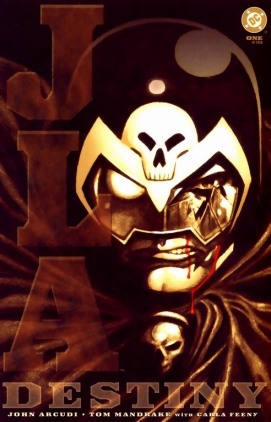
Take JLA: Destiny for instance. The four-issue miniseries is based on a concept that is so full of promise that it could have carried the story itself. They could have just plugged it into the DC Universe and let loose a great story. Writer John Arcudi decided not to, seemingly going for more of an epic clusterfuck of a story. So this big twist in DC history is made into part of a bigger theme. It also becomes merely a subplot to the whole miniseries and this big shocker that should have been the selling point for the comic isn’t fully revealed to the reader until the third issue.
A couple years back, when I first read Destiny, I scoured online for reviews. I’m too lazy to check now, but all the reviews I found were for the first two issues only. Some didn’t make it past the first. Nobody knew what the point of the story was yet and had no indication that they were going to discover it in the final two issues, so everyone dropped it like a rock.
The conflict in the story deals with a menacing third world country called Kamburu that, much like Marvel’s Latveria, harbors a mysterious supervillain ruler known only to the public as Khouriga Edjem.
Taking one look at the world’s Justice League, you see a major difference to any roster we’ve ever seen. Wonder Woman and Wally West Flash are there, sure. We have a less-impressive Batman archetype in there named Midnight and Triumph, a guy with possibly a Superman-level of strength that lacks any of the personality that regularly makes Superman the top dog of superheroes. He’s not to be confused with the Sentry-esque Triumph that appeared in DC for a while. There’s also a character named Widow, some dude named Marksman and a Spectre-looking guy named Unknown. According to Wikipedia, a lot of these guys are loosely based old Smash Comics characters. Also, for no real reason, Flash is dressed like a mix of Cyclops and Quicksilver.
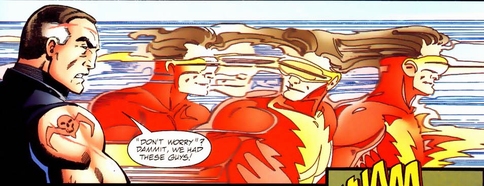
Fitting in with the theme of the comic series is Captain Thunder. Obviously, the guy has the power of Shazam, but he isn’t Billy Batson. For one, he’s black. Although it isn’t outright said, it seems apparent that Captain Thunder is Jakeem Thunder having received the Captain Marvel power set instead. On the subject of mixed up origins, the team used to have Guy Gardner as Green Lantern on the team. If you know anything about the Green Lantern origin, Guy was considered equally worthy of the ring, but it went to Hal because he was closer. Again, a mixed up origin. Keep that in mind.
A while back, Green Lantern was on a mission with fellow members the Clock and Manhunter when he was attacked and seemingly killed. This, among other things, has caused a major rift in the team. Those with powers look down on those without, as if they’re compromising the team just by being involved.
The villain Khouriga Edjem has his own team of henchmen, but they really aren’t important. For whatever reason, Aquaman is Aqualord and is a drug-addicted religious zealot. That has no bearing on anything. Plus Black Adam is a robot and Black Condor, under the name Kondor, is the team leader. Like I said, not a bunch of guys worth discussing. After failing to defeat the Justice League, Kondor is punished by Khouriga Edjem. Who does he turn out to be?
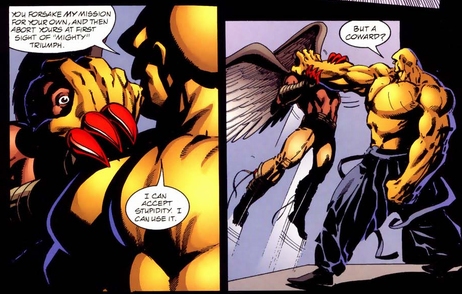
Mongul?! The plot thickens.
As for how the Justice League came to be, let’s look back at that “switched around origins” thing we saw with Green Lantern and Captain Thunder. This is one of the big two twists that make the story what it is. Years ago, the Waynes left the movie theater and were confronted with a mugger. We all know the story. Only this time, the mugger fires on Martha and young Bruce, killing them. Thomas survives, but his hand is blown off, ending his surgeon career.
He used his fortune to start up the Justice League of Gotham, made up of powerless superheroes. Successfully, they cleaned up Gotham City and turned it into a place worth living in. Then he expanded it into the current Justice League, adding super-powered heroes that make guys like Midnight and Widow obsolete.
Elsewhere, we see Lex Luthor working in Switzerland, as a way to keep his dealings neutral from politics. He’s optimistic with his beliefs that his works and discoveries will make war obsolete. When one of his workers overhears about the Justice League’s victory against Mongul’s men, Luthor wants to hear nothing of it. War is war, even if the “good guys” won.
Already, we see a difference in his personality. More than that, he’s physically different than how we know him. While he’s still bald, he has a white beard to help cover up a series of very horrible facial scars covering his lower face and neck. A light explanation is later given to help us understand. Luthor used to be a power-hungry arms dealer. A criminal. Then a major lab accident killed many of his workers and only he survived, though with his facial scars. From there on, he turned over a new leaf, working purely for a utopia, under the funding of Thomas Wayne.
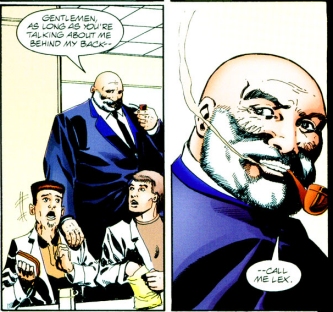
What does this mean? I suppose if you think about it hard enough, you can figure it out.
As part of the second issue, Thomas Wayne uses some of Luthor’s armor tech, adds some weaponry and uses it for his powerless League members. Midnight, Marksman and Vixen use these to help turn the tides in battle and almost get some respect from those with powers. Mongul finds out about this and Luthor’s involvement and sees the error in his plans. He should have taken care of Luthor a long time ago.
I forgot to mention another subplot. Back in the Justice League of Gotham days, Nightshade was on the team. There was a love triangle going on with her, Manhunter and Midnight, where she ended up marrying Manhunter. After the mysterious adventure that seemed to have ended the lives of Manhunter, Green Lantern and Clock, Nightshade had started having visions and could no longer function as a member of the team. She now lives alone, going slowly insane, occasionally visited by her teammates. She refers to herself as Destiny, working into the Elseworlds story’s title.
At the end of the issue, Luthor gives a tour to some folks and discusses his patents and peace-based technologies. The Human Bomb, Mongul’s not-so-suicidal terrorist bomber, yells at Luthor for being a hypocrite and a liar. He doesn’t build inventions for peace. He creates war for the Justice League. Human Bomb then uses his power to blow up the entire complex and kill everyone in the area but himself.
All of the sudden, another explosion occurs and knocks him back. This happens.
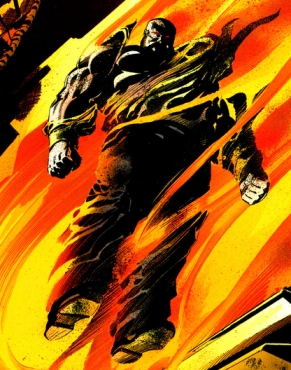
Ohhhhhh shit. We’re not hitchhiking anymore. We’re riding!
It suddenly becomes clearer, doesn’t it? You now see the point of this Elseworlds. If Thomas Wayne survived the incident that killed his wife and son, then you have to realize why an old man is invulnerable, can fly and has red eyes.
Like I said earlier, one of the botches of the miniseries is waiting until the halfway point before giving us a real idea what the story is really about when there isn’t anything else worth holding your attention for that long.
Issue three has “Luthor” go nuts, flying to America and smashing into a Waynetech building, screaming in fury for Thomas Wayne. The powered members of the Justice League go after him, but don’t fair all that well.
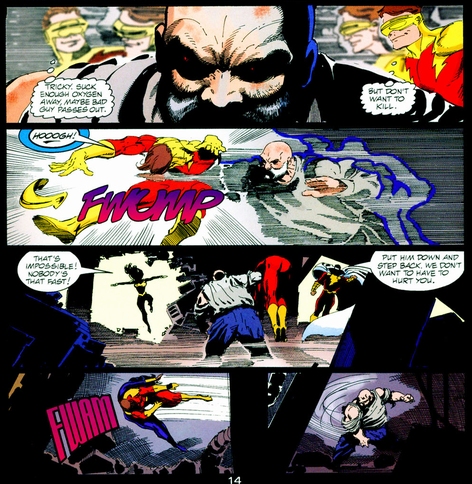
Awesome Tom Mandrake art there.
When the non-powered heroes barge in with their Luthor-created armors, “Luthor” sees what his work has led to, falls to his knees and gives up.
Later, while constrained, he speaks with Thomas Wayne.
“You took my blueprints and used them to kill, Wayne.”
“Now look—“
“I didn’t mind your profiteering, your grubbing, your grabbing. I let you make al the money you wanted off my work, but that wasn’t enough. You had to make war.”
“I heard you made a little war yourself.”
“I lost control. You drove me to it. All my time here, I worked for peace, and you twisted that. You twisted me. A man can only take so much.”
“Is that what you are, Lex? A man?”
“Where I come from, that’s all I am.”
“And just where do you come from?”
“It isn’t there anymore.”
A flashback shows that the man believed to be Lex Luthor is in fact Jor-El of Krypton. Like in the story we know, Jor-El believed that Krypton was about to explode, but the authorities refused to listen. In this version, the planet went up far before he had a chance to get his son to safety. When Krypton went up, Jor-El was outside of orbit, still testing his escape rocket. Filled with soul-crushing sorrow for his failures and inability to save his family, Jor-El moved on towards Earth.
While untamed, he found the planet suitable and familiar enough to live on. Starting a new life, he ended up working for Lexcorp, trying to help create a new kind of rocket fuel. The real Luthor, being an asshole, rushed the project and an explosion occurred. Jor-El came to life, grabbing Luthor and hopping high out of danger. He was burned, but all things considered, he should have been vaporized. It turned out that being on Earth was slowly making Jor-El more powerful.
At first, Luthor was happy about having a superhero on his payroll. He could now be on equal footing with Thomas Wayne. Jor-El didn’t want to be used like that and wanted to remain anonymous as an outsider. So how do you bargain with a man who has the world? As Jor-El put it, offer other worlds.
The two made an agreement. Luthor would fly Jor-El’s rocket into space to find other planets and Jor-El would take Luthor’s identity on Earth. With his face so messed up and fingerprints burned beyond recognition, Jor-El didn’t have too hard of a time making people believe he was Luthor.
Back to the present. With the Human Bomb and Kondor captured, the Justice League has enough evidence to go to Kamburu and take in Mongul. Jor-El overhears this with his super-hearing and decides to intervene. He easily breaks his restraints and flies to the third world country in hopes of finding a peaceful end to this.
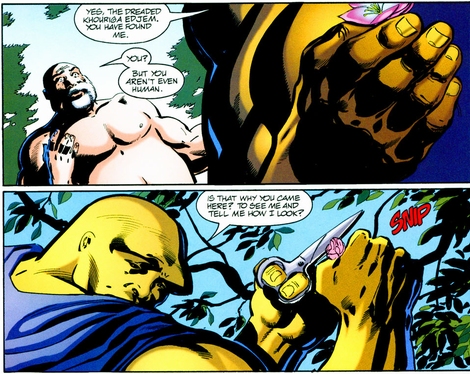
As Triumph and Black Adam brawl in the skies, Jor-El and Mongul discuss things civilly. Jor-El pleads with him to surrender and end this. Mongul, finding Jor-El intriguing, asks him to enter his study so that they can continue their conversation. Once Jor-El leaves, Triumph finishes off Black Adam and reduces him to scrap. Triumph spends a moment confused over this until Mongul loses his shit and beats the living hell out of him over the loss of his one-of-a-kind robot. He then finishes him, the Justice League’s most powerful member, by snapping his neck.
The issue ends with Jor-El’s shocking discovery that Mongul has his old rocket as part of his collection.
Back to the whole Destiny/Nightshade subplot, she has some more visions that lead her to the desert, where her husband Manhunter was slain years ago. Coincidentally, some military folks also go to that area in the desert. They all discover a large Martian body with a hole in its head. Soon all the army guys forget they saw it, but Destiny stays to talk to what’s in actuality her husband.
Paul Kirk died years ago and alien J’onn Jonzz replaced him. He took up the Manhunter mantle and met Destiny after that. He gives her all the information to discredit Mongul politically and other info that involves a subplot about America’s sudden crop failure epidemic.
There’s no follow-up to the Mongul/Triumph/Jor-El segment from the last issue at first. Instead, we see Mongul investigating a series of mysterious blackouts in Kamburu. We find that the entire country is powered by Guy Gardner, with his ring-hand hooked into some device and a Black Mercy plant attached to his chest, putting him into a blissful coma. Mongul is outraged that his flunkies have kept Guy malnourished, which explains the blackouts.
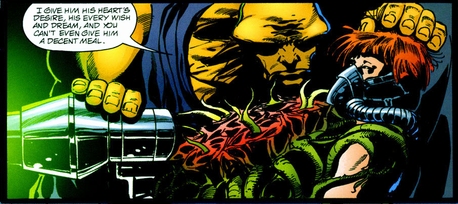
The JLA are pissed enough that they’re going to go after Mongul for killing Triumph. Thomas Wayne tries to stop them and explains Mongul’s big plan. He was using his super-terrorist henchmen as a cover as he worked on sabotaging America’s grain supply so that they’d eventually have to cave in and purchase Kamburu’s grains at an inflated price. Wayne pleads with them and says that Mongul is too smart, but they just shrug him off and leave anyway.
That begs the question. Mongul is supposed to be a world-crushing monster. In this story, he’s… well… a super-strong Lex Luthor. Why would he use a plan like this to take over the world?
We’re given the explanation as Jor-El revisits the Kansas crater from where he originally crashed. He’s depressed, knowing that whatever Mongul’s up to, it’s somehow his fault. The voice of J’onn J’onzz enters his mind, explains their connection as lone alien survivors, makes mention of how Jor-El flew away rather than confront Mongul after the Triumph incident and gives Jor-El the lowdown on what the deal is with Mongul.
Mongul used to go around destroying intergalactic civilizations like one big, yellow locust. This all changed when he discovered that one of the planets he crushed had rebuilt itself. An outsider, Lex Luthor, had become their ruler and led them to rebuild and thrive. For that, the residents of that planet worshipped Luthor as their god.
Mongul promptly annihilated that planet a second time over and put Luthor’s head on a pike. That done with, he took a second to reflect on Luthor’s style. Mongul’s reign of destruction was a nice showcase of power, but his power was worthless the moment a civilization was dead. But if he were to be like Luthor and take over a planet while making the people think him to be their savior, that power would last forever. So you see, much like Jor-El took the spot of Superman and Thomas took the spot of Bruce, Mongul takes the spot of Luthor.
He takes Luthor’s starship and uses it to navigate to Earth. That’s where Manhunter, Green Lantern and Clock met him. He tossed the Black Mercy at Lantern, shot Manhunter through the head before he could phase and then easily killed Clock. J’onn has been unable to move and is slowly dying. He’s been holding on for so long just so he can stop Mongul’s plan. Destiny’s psychic projections were really just a delirious J’onn trying to communicate with her.
Jor-El refuses to take a role in the war, but J’onn guilt trips him and explains that a man who takes no steps is a man going nowhere.
Later, at Wayne Manor, Thomas Wayne mopes over how the Justice League are going to fail. That’s when the Last Dad of Krypton makes his entrance.
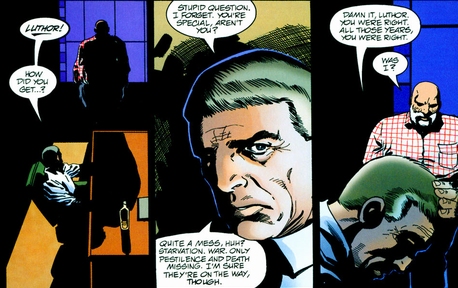
“You can’t make the world better by punching and shooting at it. I should have learned that lesson twenty years ago. A watch, a necklace, a wallet full of money. I’m Thomas Wayne, for God’s sake. I could have replaced them all with one phone call. Why didn’t I just give them to him? How different would this world be right now if I had?”
“You’re blaming yourself for all this?”
“I’m sorry, Martha. I’m so, so sorry… Bruce, my baby. My poor baby boy…”
“Thomas. I had a wife once, too. And a little boy. I’m sorry.”
Now having an idea of what to do, Jor-El flies off.
The Justice League go after Mongul and it doesn’t go so well. Being an Elseworlds, lots of characters die for the hell of it. As Mongul calmly walks outside and away from the melee, a tomahawk missile nails him. Midnight, the one behind it, gets ready to return home, victorious. Being that this is Mongul, we see him walk out of the fiery rubble and gloat about his godhood.
We see the insides of Guy Gardner’s mind under the effects of the Black Mercy. For years he’s gone on the routine of beating up bad guys and then scoring with a handful of bikini-clad women. Certainly the best Black Mercy fantasy I’ve ever seen. J’onn shows up in his head and explains the situation. Apologizing for what’s about to happen, J’onn forces Guy to awaken. Guy freaks out, the machines all go crazy and the complex goes up in a huge, green explosion.
Mongul gets furious at the explosion and Midnight, in a stupid, stupid move, attacks Mongul with barbed wire around the throat. Mongul simply punches a hole through the head area of Midnight’s battle armor. I’m sure it’s intentional that Mongul personally kills the crappy excuse for Superman and the crappy excuse for Batman.
Suddenly, a red and white streak flies over and knocks Mongul off his feet.
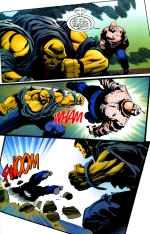
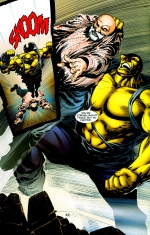
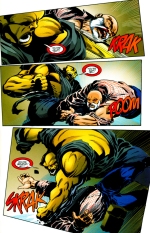
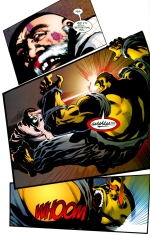
We get a quick interlude with J’onn and Destiny. Now that Mongul is dealt with, J’onn no longer has to hold on. He tells his wife to go home and fades away into nothingness.
After that? The badass conclusion.
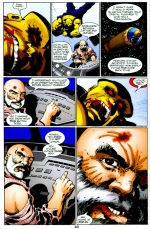
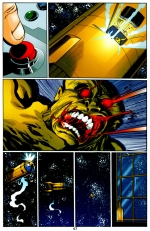
Goddamn, that’s sweet.
That last panel is an old bottle of scotch that Midnight wanted Thomas to save for when he got back from killing Mongul. The last page is Thomas and Destiny sharing the bottle while listening to the radio give us the rundown on Kamburu’s downfall. They’ve completely lost power, due to the Guy Gardner thing, and now offer their grains to America in return for relief. Pretty much the entire Justice League is dead except for Wonder Woman, Flash (who didn’t take part in that final battle) and Unknown (who was written into a coma during the first issue).
Holding up his glass, Thomas says, “Nobody lives forever.”
What an uneven story. Everything with Jor-El and Mongul was absolutely great. The Justice League and most of the Thomas Wayne stuff, not so much. It’s cool that the Jor-El stuff takes over towards the end, but it’s like a reward for having to muck through the miniseries. Midnight, for a guy who is supposed to be one of the main characters, is just so damn boring and unlikable. Some things just weren’t incorporated very well. Wonder Woman was there, but had no point. I can’t recall a single important thing she did the entire story. Same with Flash and Aqualord. Every villain other than Mongul was lame.
The end is just so very dull. Storywise, it wasn’t bad, but it just could have been told so much better.
But when it was good, it was real good, especially with the dialogue. With a little effort and cutting some of the fat, it could have been great.

Wonder woman not doing anything important? My word, that’s totally unlike nearly anything else involving her… oh wait…
Wonder Woman does less than usual here. Like, she could have been forgotten about completely and it wouldn’t have altered a single piece of the story. Yeah, she gets designated to the backseat in most team stories, but at least here she’s meant to have some semblance of importance. She’s the most important DC character who isn’t altered in some major way.
I don’t know. Maybe I missed some important clue that it wasn’t Diana, but Queen Hippolyta as Wonder Woman. That would have at least fit with the story.
I’ve seen this book every once in a while, in clearance racks and so forth, and every time I see that helmet on the first cover, I think, “Why is Judge Dredd in the Justice League?” Well, thanks for clearing that up!